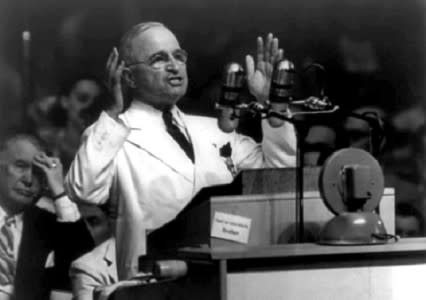On This Day, Truman, Congress decide current line of presidential succession
On this day in 1947, Congress changed the order of who can succeed the President and Vice President in office, more closely reflecting the wishes of the Founding Fathers.
When the Constitution was written in 1787, the issue of who takes the President’s place in case of death, disability or resignation was murky at best. It took until 1841 for John Tyler, the first Vice President to face the problem and settle the question – at least until the 25th Amendment was ratified in 1967.
After William Henry Harrison died just a month after his own inauguration in April 1841, Tyler decided to take the oath as President – and not as Acting President as some people suggested. The precedent held for eight instances until the 25th Amendment was ratified.
But what happens when the offices of President and Vice President are vacant at the same time and no one can “discharge the powers and duties of the office of President?” In 1791, responsibility for deciding the line of succession was left to the First Congress. A House committee suggested that Secretary of State Thomas Jefferson, an anti-Federalist, be named as third-in-line to the White House, an idea opposed by the Federalists.
Instead, the Second Congress agreed in 1792 that the Senate President Pro Tempore and then the Speaker of the House would serve as Acting President until a disability was removed that prevented a President or Vice President from serving, or until a new election was held. (In that case in 1792, Richard Henry Lee and Jonathan Trumbull were next in line as Acting President.)
The original presidential succession act had some problems, specifically related to the Constitution’s missing provision to name a replacement Vice President for when that office became vacant. (That 25th Amendment also addressed that problem.)
In 1886, Congress and the Grover Cleveland administration pressed for changes in the secession act after Cleveland’s Vice President, Thomas Hendricks, had died. Also, the Senate had been unable to agree on a President Pro Tempore after President James Garfield was shot and dying.
The new version made the Secretary of State third-in-line, and then other Cabinet members based on the tenure of their departments. Importantly, a special election wasn’t required to choose a new President. The Acting President would serve until the next scheduled election was concluded in the Electoral College.
In late 1945, President Harry Truman had succeeded Franklin Roosevelt and he pressed for a return to the succession line from the 1792 act with one important difference: The House Speaker would be the third-in-line for the White House, followed by the Senate President Pro Tempore. The special election would return to fill White House vacancies.
Congress passed a revised version of this plan, which was signed by Truman and enacted on July 18, 1947. There would be no special election provision, and Cabinet officers, based on their department’s tenure, followed the House Speaker and the Senate President Pro Tempore in the line of succession. Anyone serving in the role of Acting President needed to resign the office they held that allowed them to serve as Acting President.


